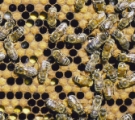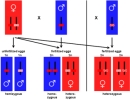« Prev Next »
In honeybees (or honey bees), sex is normally determined by the fertilization or non-fertilization of eggs, rather than the presence or absence of sex chromosomes. This mode of sex determination was first discovered by Johann Dzierzon, a Catholic priest, in 1845. Dzierzon reported that a virgin queen which has not taken a mating flight (the queens mate only while in free flight away from nest) produces only male progeny (Dzierzon et al., 1945). His report was the first rigorous description of a sex determination system, occurring more than 50 years before the discovery of sex chromosomes (McClung, 1902; Wilson, 1905). We now know that honey bees are not unique and that about 20% of animal species use a haplodiploid mode of reproduction. In haplodiploid systems, male progeny normally develops from unfertilized eggs, which are haploid and have just one set of chromosomes. The fertilized honey bee eggs, which are diploid and have two sets of chromosomes, differentiate into queens and worker bees.
Complementary Sex Determination

The isolation of the sex determination locus in honey bees led to the identification of the complementary sex determiner (csd) gene (Beye et al., 2003) (Figure 3A). The csd gene encodes a potential splicing factor that exists in at least 15 allelic variants that differ on average in ~3% of their amino acid residues (Hasselmann and Beye, 2004). The csd gene product is necessary for female development, because inactivation of csd gene product in female embryos causes a full switch into male development (Beye et al., 2003). The target of the csd gene product was recently identified as the feminizer (fem) gene (Hasselmann et al., 2008) (Figure 3A). The fem transcript is splicing differently in males and females, so that only female cells have a functional fem gene product. In males, splicing introduces a stop codon into the fem coding sequence.
Evolution of Complementary Sex Determination
References and Recommended Reading
Beye, M., Hasselmann, M., Fondrk, M. K., Page, R. E. & Omholt, S. W. The gene csd is the primary signal for sexual development in the honeybee and encodes an SR-type protein. Cell 114, 419-429 (2003).
Charlesworth, D., Charlesworth, B. & Marais, G. Steps in the evolution of heteromorphic sex chromosomes. Heredity (2005).
Dzierzon, J. Gutachten über die von Herrn Direktor Stöhr im ersten und zweiten Kapitel des General-Gutachtens aufgestellten Fragen. Eichstädter Bienenzeitung 1, 109-113, 119-121 (1845).
Hasselmann, M. & Beye, M. Signatures of selection among sex-determining alleles of the honey bee. Proc Natl Acad Sci U S A 101, 4888-4893 (2004).
Hasselmann, M. et al. Evidence for the evolutionary nascence of a novel sex determination pathway in honeybees. Nature 454, 519-522 (2008). doi:10.1038/nature07052 (link to article)
Mackensen, O. Viability and sex determination in the honey bee (Apis mellifera L.). Genetics 36, 500-509 (1951).
McClung, C. E. The accessory chromosome - sex determinant? Biol. Bull. Mar. Biol. Lab. , Woods Hole 3, 43-84 (1902).
Whiting, P. W. Selective fertilization and sex-determination in Hymenoptera. Science 78, 537-538 (1933).
Whiting, P. W. Multiple alleles in complementary sex determination of Habrobracon. Genetics 28, 365-382 (1943).
Wilson, E. B. The chromosomes in relation to determination of sex in insects. Science 22, 500-502 (1905).




 Figure 1
Figure 1



























